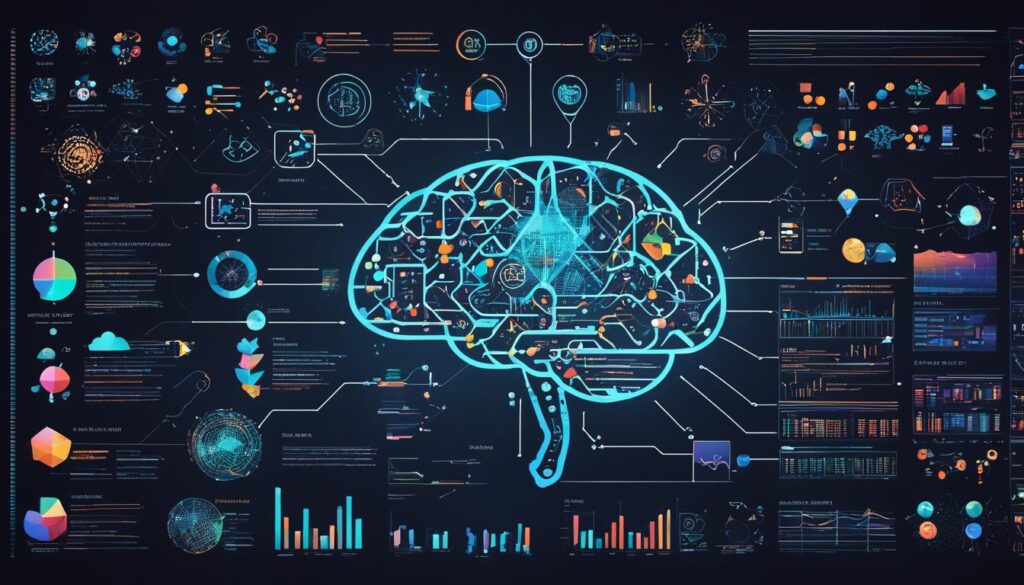Machine learning is a complex field within artificial intelligence (AI) that requires a basic understanding of programming. There are several programming languages commonly used in machine learning and AI projects. Python, R, C++, and Java are among the top programming languages for AI and neural networks. These languages offer various advantages in terms of ease of use, performance, community support, and availability of libraries and frameworks.
Contents
- 1 Understanding Machine Learning
- 2 Important Skills for Machine Learning
- 3 Python: The Best Language for Machine Learning
- 4 R: An Excellent Language for Statistical Analysis
- 5 C++ and Java: Performance and Control
- 6 Other Programming Languages for Neural Networks
- 7 Conclusion
- 8 FAQ
- 8.1 Which programming languages are commonly used for artificial intelligence and neural networks?
- 8.2 What is machine learning?
- 8.3 What skills are important for machine learning?
- 8.4 Why is Python considered the best language for machine learning?
- 8.5 What advantages does R offer in machine learning?
- 8.6 Why are C++ and Java preferred for machine learning?
- 8.7 Are there any other programming languages for neural networks?
- 8.8 How can I choose the best programming language for neural networks?
- 9 Source Links
Key Takeaways:
- Python, R, C++, and Java are the best programming languages for AI and neural networks.
- These languages offer advantages in terms of ease of use, performance, community support, and availability of libraries and frameworks.
- Machine learning is a complex field within AI that involves training computer algorithms to learn from data.
- Python is known for its simplicity, readability, and versatility in machine learning.
- R is ideal for in-depth analysis and visualization of neural network models.
Understanding Machine Learning
Machine learning is an essential part of artificial intelligence (AI). It involves the study of computer algorithms that learn from data without the need for explicit programming. Instead, these algorithms use training data to identify patterns and trends, allowing them to make predictions and decisions independently. Machine learning plays a significant role in various fields, including natural language processing, computer vision, and fraud detection, among others. With its ability to analyze and interpret complex data, machine learning is transforming industries and driving innovation.
Machine learning algorithms are designed to process large datasets, learn from them, and then apply this knowledge to new data to make accurate predictions or take meaningful actions. They use statistical techniques and mathematical models to find patterns and create connections between data points. This process enables machine learning algorithms to continuously improve their performance and make more accurate predictions over time.
Through machine learning, computers can analyze vast amounts of data and provide insightful results and recommendations. Whether it’s identifying patterns in customer behavior, predicting stock market trends, or detecting fraudulent activities, machine learning algorithms empower businesses to make informed decisions and drive strategic growth.
In the words of Andrew Ng, a prominent figure in machine learning, “Machine learning is the science of getting computers to act without being explicitly programmed.”
Machine learning is a dynamic and rapidly evolving field with countless applications. From self-driving cars to personalized product recommendations, machine learning algorithms are revolutionizing the way we live and work. To fully leverage the power of machine learning, it is essential to understand the different types of machine learning algorithms, their strengths, and their limitations.
The Types of Machine Learning Algorithms
Machine learning algorithms can be broadly categorized into the following types:
- Supervised Learning: Supervised learning algorithms learn from labeled data, where each data point has a corresponding target or outcome variable. These algorithms are trained to predict future outcomes based on historical data.
- Unsupervised Learning: Unsupervised learning algorithms work with unlabeled data and aim to find patterns or relationships within the data without specific guidance. These algorithms identify hidden structures in the data and group similar data points together.
- Reinforcement Learning: Reinforcement learning algorithms learn through trial and error. They interact with an environment, receive feedback in the form of rewards or penalties, and learn to optimize their actions to maximize rewards. These algorithms are often used in robotics, game playing, and resource management.
Each type of machine learning algorithm has its unique characteristics and applications. Understanding their differences and capabilities is crucial for effectively applying machine learning techniques to real-world problems.
| Algorithm Type | Description | Example Applications |
|---|---|---|
| Supervised Learning | Uses labeled data to train algorithms and make predictions based on historical patterns. | Image classification, spam detection, fraud detection |
| Unsupervised Learning | Identifies hidden patterns in unlabeled data and groups similar data points together. | Clustering, anomaly detection, market segmentation |
| Reinforcement Learning | Teaches algorithms to learn through trial and error, optimizing actions to maximize rewards. | Game playing, robotics, autonomous vehicles |
As machine learning continues to advance, new algorithms and techniques are being developed to tackle more complex problems and enhance decision-making processes. Staying updated with the latest advancements and understanding the underlying principles of machine learning is crucial for professionals in the field.
https://www.youtube.com/watch?v=ZpmJKqNUL0k
In the next section, we’ll explore the essential skills for machine learning professionals and discuss how to excel in this rapidly evolving field.
Important Skills for Machine Learning
To excel in machine learning, you need to possess a strong foundation in data analytics and programming. Mastering these essential skills is crucial for developing and implementing machine learning models effectively. Here are the key skills you should focus on:
-
Programming Language Proficiency: A solid understanding of at least one programming language is vital for machine learning. Python, R, C++, and Java are popular choices. Python, in particular, is widely used in the field due to its versatility and extensive library support.
-
Statistical Concepts: Familiarity with statistical concepts is essential for analyzing and interpreting data. Understanding concepts such as probability, hypothesis testing, and regression analysis will greatly enhance your ability to develop and evaluate machine learning models.
-
Deep Learning Algorithms: Deep learning plays a significant role in modern machine learning applications. Acquiring knowledge and proficiency in deep learning algorithms, such as convolutional neural networks (CNNs) and recurrent neural networks (RNNs), will allow you to tackle complex problems and achieve state-of-the-art results.
-
Systems Process and Design: Machine learning often involves working with large datasets and complex systems. An understanding of systems process and design principles will help you manage and optimize your machine learning pipelines, ensuring efficient computation and scalability.
Why Are These Skills Important?
“Having a strong foundation in data analytics and programming skills enables you to effectively navigate the world of machine learning. Understanding programming languages, statistical concepts, deep learning algorithms, and systems process will empower you to develop innovative and successful machine learning solutions.”
Building expertise in these areas will make you a valuable asset in the realm of machine learning. Keep in mind that the field is rapidly evolving, and staying updated with the latest trends, techniques, and advancements is crucial for continued success.

Python: The Best Language for Machine Learning
When it comes to machine learning, Python reigns as one of the most popular and influential programming languages. With its simplicity, readability, and versatility, Python has become the go-to language for AI and machine learning projects.
One of the biggest advantages of Python is its vast collection of libraries tailored specifically for machine learning. These libraries, such as TensorFlow, Keras, and PyTorch, offer high-level abstractions and pre-built components that simplify the process of building and training neural networks.
Python’s extensive community support is another reason why it’s widely preferred in the AI community. The passionate and active Python community is always ready to provide guidance and assistance, making it easier for developers to solve problems and stay updated with the latest trends and techniques.
Python not only excels in machine learning but also offers seamless integration with other data analytics tools. Its compatibility with popular libraries and frameworks makes it an ideal choice for data scientists and AI enthusiasts.
“Python’s simplicity, readability, and vast array of libraries make it the perfect language for developing powerful and efficient AI and machine learning models.”
If you’re just starting your machine learning journey or looking to expand your skills, Python is an excellent choice. Its beginner-friendly syntax and comprehensive documentation make it easy to learn and use.
Advantages of Python for AI
- Easy to learn and use: Python’s straightforward syntax and clean structure make it accessible to both experienced programmers and beginners.
- Versatility: Python can be used for a wide range of tasks, from data preprocessing and analysis to building complex machine learning models.
- Extensive library support: Python’s extensive library ecosystem, including popular frameworks like TensorFlow and PyTorch, enables developers to quickly implement advanced AI models.
- Community support: Python’s active and passionate community provides constant support, resources, and tutorials, ensuring that you’ll always have help when you need it.
- Integration with existing tools: Python seamlessly integrates with other data analytics tools such as Jupyter Notebook, making it easy to incorporate machine learning into your existing workflows.
R: An Excellent Language for Statistical Analysis
When it comes to machine learning and neural network programming, R proves to be an exceptional programming language. Originally developed for statistical analysis, R has evolved into a powerful tool for AI applications. With its extensive statistical capabilities, R is particularly well-suited for in-depth analysis and visualization of neural network models.
In addition to its core features, R boasts a wide range of packages that enhance the development and training of neural networks. Two notable packages are caret and neuralnet. The caret package offers a comprehensive toolkit for training, testing, and fine-tuning machine learning models, while the neuralnet package provides a robust set of functions for designing and implementing neural networks.
Whether you’re exploring complex datasets or creating advanced neural network models, R provides the necessary tools and resources to facilitate your AI journey. Its integration with statistical analysis, visualization capabilities, and specialized packages makes R an invaluable language for AI enthusiasts and professionals alike.
“R’s statistical prowess and extensive package ecosystem make it a go-to choice for analyzing and visualizing neural network models, empowering data scientists to unlock valuable insights.”
With R’s rich functionality, you can easily manipulate, analyze, and visualize data, allowing for a deeper understanding of your neural network models and their performance. This analysis can be crucial in detecting patterns, identifying trends, and making data-driven decisions.
Advantages of R in AI:
- Extensive statistical capabilities
- Specialized packages for neural network development and training
- Integrated statistical analysis and visualization
- Supportive community and active development
With its unique strengths and contributions to the field of AI, R stands as an excellent choice for statistical analysis in the realm of neural networks.

| Advantages of R in AI | Description |
|---|---|
| Extensive statistical capabilities | R provides a wide range of statistical functions and packages that facilitate in-depth analysis of neural network models. |
| Specialized packages for neural network development and training | Packages like caret and neuralnet offer comprehensive tools and functions specifically designed for building and training neural networks. |
| Integrated statistical analysis and visualization | R seamlessly integrates statistical analysis and visualization, allowing for a holistic approach to understanding and interpreting neural network models. |
| Supportive community and active development | The R community is thriving, with active development and dedicated forums, making it easy to find support and stay updated with the latest advancements. |
C++ and Java: Performance and Control
When it comes to machine learning, developers seeking maximum performance and low-level control often turn to C++ and Java. These programming languages offer unique advantages that make them preferred choices in the field of AI.
C++ for machine learning: C++ is widely used in industries that require real-time processing, such as gaming. Its efficient memory management and low-level control make it an ideal language for implementing complex neural network architectures. With C++, developers can fine-tune their algorithms and optimize performance, resulting in faster and more accurate AI models.
Java for machine learning: On the other hand, Java provides platform independence, allowing developers to create AI applications that can be seamlessly deployed across different operating systems. Java’s robust ecosystem and strong community support make it a reliable choice for building AI solutions. With Java, developers can leverage the vast array of existing libraries and frameworks, simplifying the development process and saving time.
Both C++ and Java have proven their worth in the realm of machine learning. The choice between the two depends on specific project requirements. If performance and low-level control are paramount, C++ is the way to go. If platform independence and community support are key considerations, Java is the language of choice.
To summarize:
| C++ for Machine Learning | Java for Machine Learning |
|---|---|
| Maximizes performance | Offers platform independence |
| Enables low-level control | Strong community support |
| Ideal for complex neural network architectures | Seamless deployment across different OS |

Other Programming Languages for Neural Networks
In addition to popular programming languages like Python, R, C++, and Java, there are several other alternative options worth considering in the AI and machine learning community. These lesser-known languages offer unique features and functionalities for developing neural networks.
Julia: High Performance and Easy Integration
Julia is gaining attention in the AI community due to its high-performance capabilities and easy integration with existing Python and R code. It combines the best features of both languages, making it an attractive choice for researchers and data scientists. Julia’s just-in-time (JIT) compilation provides fast and efficient execution, while its extensive library ecosystem allows for seamless integration with popular AI frameworks.
Lua: Niche Language for AI Development
Lua, a lightweight and flexible scripting language, has primarily been utilized in game development. However, it has found a niche in the AI field with frameworks like Torch and LuaJIT. Lua’s simplicity and ease of embedding make it a great choice for prototyping and experimenting with neural networks. It also offers efficient memory management and powerful debugging capabilities, further enhancing its usability for AI projects.
“Julia combines the speed of C with the ease of use of Python, making it a powerful language for AI research and development.” – Dr. Jane Chen, AI Researcher
These lesser-known programming languages provide developers with alternative options for implementing neural networks. While Python, R, C++, and Java remain the dominant choices, exploring languages like Julia and Lua can open up new possibilities and expand the toolkit of AI practitioners.

| Programming Language | Strengths | Use Cases |
|---|---|---|
| Julia | High performance, easy integration, extensive library ecosystem | Research, data analysis, scientific computing |
| Lua | Lightweight, flexible, efficient memory management | Prototyping, game development, AI experimentation |
Conclusion
When it comes to choosing the best programming language for AI and neural networks, several factors come into play. Python, R, C++, and Java stand out as top contenders, each with their own advantages and specific use cases. Before making a decision, it is essential for developers to evaluate their project requirements and consider the available resources and community support.
Python is highly popular for machine learning due to its simplicity, versatility, and extensive library support. It offers powerful frameworks like TensorFlow and Keras, making it an excellent choice for building and training neural networks.
R, originally developed for statistical analysis, offers robust capabilities for in-depth analysis and visualization of neural network models. It provides numerous packages that facilitate the development and training of neural networks.
C++ and Java excel in performance and low-level control, making them suitable for tasks requiring real-time processing and complex neural network architectures. C++ offers efficient memory management, while Java’s platform independence allows for multi-platform deployment.
Regardless of the language chosen, staying up-to-date with the latest developments and techniques in neural networks is crucial for success in AI and machine learning projects.
FAQ
Which programming languages are commonly used for artificial intelligence and neural networks?
The top programming languages for AI and neural networks are Python, R, C++, and Java.
What is machine learning?
Machine learning is a subset of AI that involves the study of computer algorithms learning from data without being explicitly programmed.
What skills are important for machine learning?
Key skills for machine learning include knowledge of at least one programming language, understanding of statistical concepts, familiarity with deep learning algorithms, and proficiency in systems process and design.
Why is Python considered the best language for machine learning?
Python is known for its simplicity, readability, and versatility. It offers a wide range of libraries such as TensorFlow, Keras, and PyTorch, which provide high-level abstractions and pre-built components for building and training neural networks.
What advantages does R offer in machine learning?
R has extensive statistical capabilities, making it ideal for in-depth analysis and visualization of neural network models. It also provides numerous packages, such as caret and neuralnet, that facilitate the development and training of neural networks.
Why are C++ and Java preferred for machine learning?
C++ offers maximum performance and low-level control, making it suitable for industries such as gaming. Java provides platform independence and is commonly used for developing AI applications that can be deployed across different operating systems.
Are there any other programming languages for neural networks?
Yes, there are several other programming languages gaining attention in the AI community, such as Julia, which is known for its high-performance capabilities, and Lua, which has found a niche in AI with frameworks like Torch and LuaJIT.
How can I choose the best programming language for neural networks?
The choice of the best programming language depends on factors such as ease of use, performance, community support, and availability of libraries and frameworks. Developers should evaluate their project requirements and consider the resources and community support available before making a decision.
Note: Include link to the sections according to the platform requirements.




